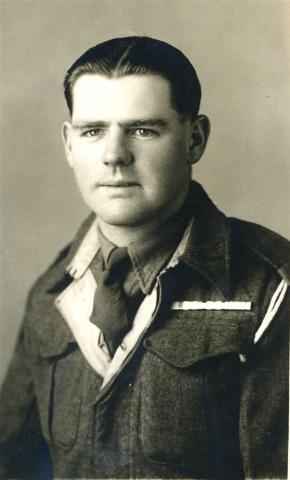‘Sandy Masterton joined the Territorial Army as a boy soldier in 1938. One of his instructors told him, “All young soldiers are curious soldiers, all old soldiers are cautious soldiers.”
‘Drummer Alexander ‘Sandy’ Masterton and Piper Malcolm Cockerill of the 70th Battalion Argyll & Sutherland Highlanders, stationed at Fort George near Inverness, saw a notice in 1942 asking for volunteers for Airborne duties; they applied and joined ‘T’ Company in August.
‘Sandy’, who had originally enlisted in the 8th (Territorial) Battalion, The Argyll & Sutherland Highlanders in March 1938, recalls that Lieutenant Cleasby was better known by his nickname ‘Tracker’ and his oft quoted phrase “We’ll catch the Bosche with his trousers down”.
“Along with other volunteers,” he recalls, “I was in Training Company and I think that we were told we had a month to prove ourselves fit for Airborne duties. Those that failed were RTU’d [Returned To Unit]. In charge of training were Lt. Cleasby and Sergeant Clark, who was later to win the DCM at Arnhem. Training was hard, over fields, through muddy stinking drains and the dreaded run and walks. For this you wore full kit, steel helmet and carried you rifle. Then you were marched on to the road. When “Tracker” blew his whistle you ran a distance of two telegraph poles, walked two telegraph poles then ran for two poles; this was kept up for miles until you thought you were going to die. Our instructors were also in full kit, so they must have been very fit. Those that fell out were medically examined and usually given another chance before being RTU’d."
Note: According to the Reverend Cleasby, ‘Tracker’ was bestowed upon him by Major John Gibbon after he had taught members of the Intelligence Section how to light a fire and cook a meal for themselves while they were training at Glanusk Park in 1941.
By the time ‘Sandy’ Masterton had completed T Company and received his coveted red beret, he was posted to ‘H’ Company. The battalion had to wait for their anti-tank guns, but then received the new 6-pounder. The first and subsequent training ‘shoots’ were held on the Royal Artillery ranges at Larkhill. ‘Sandy’s’ gun was named “Scimitar Hill”; it was commanded by Sergeant ‘Johnny’ Molloy with Private ‘Danny’ Farrell as the No 1, ‘Sandy’ as No 2, Gordon Ennion as No 3 and Gordon Haskins as the jeep driver; all eight guns in the two anti-tank platoons were jeep-hauled. All the 6-pounders were named after Regimental Battle Honours: ‘Arroyo’, ‘Marne’, ‘Ypres’, ‘Somme’, ‘Arras’, ‘Cambrai’, ‘Gallipoli’, ‘Scimitar Hill’. ‘Suvla Bay’ and ‘Hellespont’. If a gun was lost or replaced, the name was carried on, as for example ‘Gallipoli II’.
He sailed from Liverpool to Oran in North Africa on board the M.V. (Motor Vessel) Staffordshire in May 1943. He went onto to see active service in Italy, September - November 1943. They returned to North Africa from the port of Taranto and then along with the rest of the 1st Battalion Borders he set sail for the U.K. 28th November on board the H.M.T. Duchess of Bedford, sailing from Philipville and docked at Liverpool on 10th December 1943.
In 1944 he was posted to 25 Anti-Tank Platoon, Support Company, having been trained on the 6 pounder anti-tank gun. In July the battalion moved from its base at Woodhall Spa in Lincolnshire to Burford, to be nearer their mounting airfields for any future airborne operation. It was whilst they were engaged in the tedious business of unloading the glider, after yet another cancelled operation, that he was involved in a quite serious accident. He and another gun crew member were holding the trail legs and doing up the trail leg bolts when the two men holding down the barrel, still partly inside the glider, let go to early and it rolled down the loading ramp and over ‘Sandy’s’ left foot cutting it quite badly. With blood coming over the top of his boot he was propped up beside the glider until a truck could be fetched and he was taken to a nearby first aid facility. Here the medical staff were quite overrun with casualties arriving from Normandy and his treatment was basic to say the least!
He was the No 2 on ‘Scimitar Hill’ attached to C-Company, along with the gun of Sgt French for the operation at Arnhem. He returned across the Rhine at the end of the operation and his full account is linked below.
‘Sandy’ stayed behind, on Rear-Party, in the U.K. when the battalion went to Norway in May 1945. After Norway it was announced that the two Airborne Division’s would be amalgamated and all the glider-borne infantry units would be posted out to ‘ordinary’ Infantry Division’s. ‘Sandy’ went with the battalion to Germany in late 1945 to the 5th Infantry Division, where he served until demobbed in August 1946.





Latest Comments
On the opposite page there is a note from other veteran, Tom Hicks, 1 para squadron, royal engineer, written in the same period.
It was quite suprise for me to find these notes after I bought the book, second hand, on the "Deventer boekenmarkt". I find it touching to see and read these notes from men who actually fought to liberate my country.
If there are any relatives interested, I will hand the book to them.
Add Comment
In order to add comments you must be registered with ParaData.
If you are currently a ParaData member please login.
If you are not currently a ParaData member but wish to get involved please register.